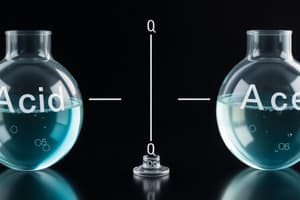Podcast
Questions and Answers
Of the following, (blank) is a weak acid.
Of the following, (blank) is a weak acid.
HF
Which of the following is the weakest acid?
Which of the following is the weakest acid?
- HNO2 (Ka = 4.5x10^-4)
- Acetic Acid (Ka = 1.8x10^-5)
- HF (Ka = 6.8x10^-4)
- HClO (Ka = 3.0x10^-8)
- HCN (Ka = 4.9x10^-10) (correct)
Classify the following compounds as weak acids (W) or strong acids (S): nitrous acid, hydrochloric acid, hydrofluoric acid.
Classify the following compounds as weak acids (W) or strong acids (S): nitrous acid, hydrochloric acid, hydrofluoric acid.
- SSS
- WSW (correct)
- WSS
- WWW
- SWW
A- is a weak base. Which equilibrium corresponds to the equilibrium constant Ka for HA?
A- is a weak base. Which equilibrium corresponds to the equilibrium constant Ka for HA?
Which of the following ions will act as a weak base in water?
Which of the following ions will act as a weak base in water?
Using the data in the table, which of the conjugate bases below is the weakest base?
Using the data in the table, which of the conjugate bases below is the weakest base?
Using the data in the table, which of the following conjugate acids below is the strongest acid?
Using the data in the table, which of the following conjugate acids below is the strongest acid?
Of the following substances, an aqueous solution of (blank) will form basic solutions?
Of the following substances, an aqueous solution of (blank) will form basic solutions?
A 0.1 M solution of (blank) has a pH of 7.0.
A 0.1 M solution of (blank) has a pH of 7.0.
What is the conjugate acid of NH3?
What is the conjugate acid of NH3?
Which one of the following pairs cannot be mixed together to form a buffer solution?
Which one of the following pairs cannot be mixed together to form a buffer solution?
What change will be caused by the addition of a small amount of HCl to a solution containing fluoride ions and hydrogen fluoride?
What change will be caused by the addition of a small amount of HCl to a solution containing fluoride ions and hydrogen fluoride?
In a solution, when the concentrations of a weak acid and its conjugate base are equal, (blank).
In a solution, when the concentrations of a weak acid and its conjugate base are equal, (blank).
The addition of hydrofluoric acid and (blank) to water produces a buffer solution.
The addition of hydrofluoric acid and (blank) to water produces a buffer solution.
Which of the following could be added to a solution of sodium acetate to produce a buffer?
Which of the following could be added to a solution of sodium acetate to produce a buffer?
Which of the following could be added to a solution of acetic acid to prepare a buffer?
Which of the following could be added to a solution of acetic acid to prepare a buffer?
Which compound listed below has the greatest molar solubility in water?
Which compound listed below has the greatest molar solubility in water?
Which compound listed below has the smallest molar solubility in water?
Which compound listed below has the smallest molar solubility in water?
For which salt should the aqueous solubility be most sensitive in water?
For which salt should the aqueous solubility be most sensitive in water?
The pH of a solution prepared by mixing 50.0 mL of 0.125 M KOH and 50.0 mL of 0.125 M HCl is, (blank).
The pH of a solution prepared by mixing 50.0 mL of 0.125 M KOH and 50.0 mL of 0.125 M HCl is, (blank).
The concentration of iodide ions in a saturated solution of silver iodide is (blank) M. The solubility product constant of AgI is 8.3x10^-17.
The concentration of iodide ions in a saturated solution of silver iodide is (blank) M. The solubility product constant of AgI is 8.3x10^-17.
The thermodynamic quantity that expresses the degree of disorder in a system is, (blank).
The thermodynamic quantity that expresses the degree of disorder in a system is, (blank).
Which of the following statements is false?
Which of the following statements is false?
The concentration of iodide ions in a saturated solution of lead (II) iodide is, (blank) M. The solubility product constant of PbI2 is 1.4x10^-8.
The concentration of iodide ions in a saturated solution of lead (II) iodide is, (blank) M. The solubility product constant of PbI2 is 1.4x10^-8.
Flashcards
Weak Acid
Weak Acid
An acid that does not completely dissociate in water.
Weakest Acid
Weakest Acid
The acid with the smallest acid dissociation constant (Ka).
Strong Acid
Strong Acid
An acid that completely dissociates in water.
Weak Base
Weak Base
Signup and view all the flashcards
Weakest Conjugate Base
Weakest Conjugate Base
Signup and view all the flashcards
Strongest Conjugate Acid
Strongest Conjugate Acid
Signup and view all the flashcards
Buffer Solution
Buffer Solution
Signup and view all the flashcards
Buffer Components
Buffer Components
Signup and view all the flashcards
Solubility Product (Ksp)
Solubility Product (Ksp)
Signup and view all the flashcards
Greatest Molar Solubility
Greatest Molar Solubility
Signup and view all the flashcards
Smallest Molar Solubility
Smallest Molar Solubility
Signup and view all the flashcards
Change in Entropy
Change in Entropy
Signup and view all the flashcards
Entropy and Spontaneous Processes
Entropy and Spontaneous Processes
Signup and view all the flashcards
Neutral pH
Neutral pH
Signup and view all the flashcards
Conjugate Acid of Ammonia
Conjugate Acid of Ammonia
Signup and view all the flashcards
Buffer Composition
Buffer Composition
Signup and view all the flashcards
Effect of HCl addition(to fluoride solution)
Effect of HCl addition(to fluoride solution)
Signup and view all the flashcards
Equal concentrations of weak acid and conjugate base
Equal concentrations of weak acid and conjugate base
Signup and view all the flashcards
Lead Iodide Solubility
Lead Iodide Solubility
Signup and view all the flashcards
Study Notes
Acid-Base Concepts
- Weak acid identified: Hydrofluoric acid (HF) is a weak acid compared to strong acids like HCl, HBr, HNO3, and HClO4.
- Weakest acid from options: Hydrocyanic acid (HCN) has the lowest acid dissociation constant (Ka = 4.9x10^-10), making it the weakest acid among the listed options.
- Classification of acids: Nitrous acid (weak), Hydrochloric acid (strong), and Hydrofluoric acid (weak) classified as weak (W), strong (S) giving WWW-weak, strong, weak classification.
Equilibrium and Bases
- Weak base equilibrium: A- + H2O ↔ HA + OH- corresponds to Ka equilibrium for HA.
- Weak base identification: Hypochlorite ion (ClO-) acts as a weak base in water, while Cl−, NO3−, and OH− do not.
- Weakest conjugate base: Fluoride ion (F-) is the weakest base among the options provided.
Strong Acids and Buffers
- Strongest acid identification: Conjugate acidNH3CH3+ is considered the strongest from the given set.
- Basic solution formation: Solutions containing sodium fluoride (NaF) and potassium carbonate (K2CO3) will form basic solutions, while NH4Cl and Cu(NO3)2 will not.
- Neutral pH solution: A 0.1 M NaNO3 solution has a neutral pH of 7.0.
Conjugate Acids and Mixing Solutions
- Conjugate acid of ammonia (NH3): Corresponds to ammonium ion (NH4+).
- Buffer formation: NaCl and HCl cannot form a buffer system.
- Effect of HCl addition: Adding HCl to a solution of fluoride ions and hydrogen fluoride increases H+ ion concentration, drives equilibrium towards hydrogen fluoride, and decreases fluoride ion concentration.
Buffer Solutions Preparation
- Equal concentrations of weak acid and conjugate base: At this point, -log of H+ concentration equals -log of Ka, indicating equilibrium.
- Hydrofluoric acid can be mixed with NaOH to create a buffer solution.
- Sodium acetate can produce a buffer with either acetic acid or hydrochloric acid.
Solubility and Molarity
- Greatest molar solubility: Calcium fluoride (CaF2) exhibits the greatest molar solubility compared to CdCO3, Cd(OH)2, AgI, and ZnCO3.
- Smallest molar solubility: Silver iodide (AgI) has the least molar solubility among the listed compounds.
- Aqueous solubility sensitivity: Calcium fluoride (CaF2) solubility is most sensitive to changes in water.
Thermodynamics and Entropy
- Change of state: The change in entropy depends on the initial and final states and the path taken between them.
- Entropy in spontaneous processes: Any irreversible process leads to an increase in entropy, and the universe's entropy always increases in spontaneous reactions.
- Entropy correlates with microstates: More microstates equate to greater entropy within the system.
Lead Iodide Solubility
- Concentration of iodide ions in saturated lead (II) iodide solution corresponds to a solubility product constant (Ksp) of 1.4x10^-8.
Studying That Suits You
Use AI to generate personalized quizzes and flashcards to suit your learning preferences.




